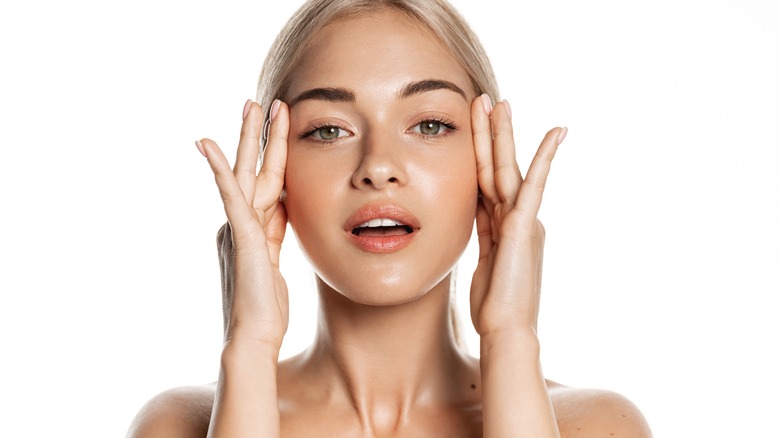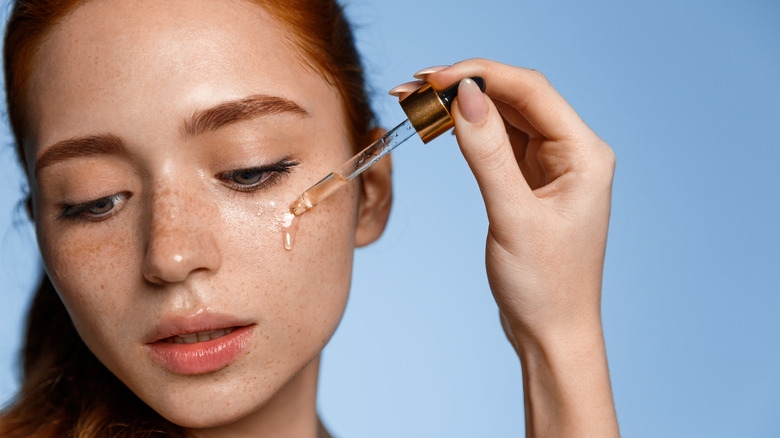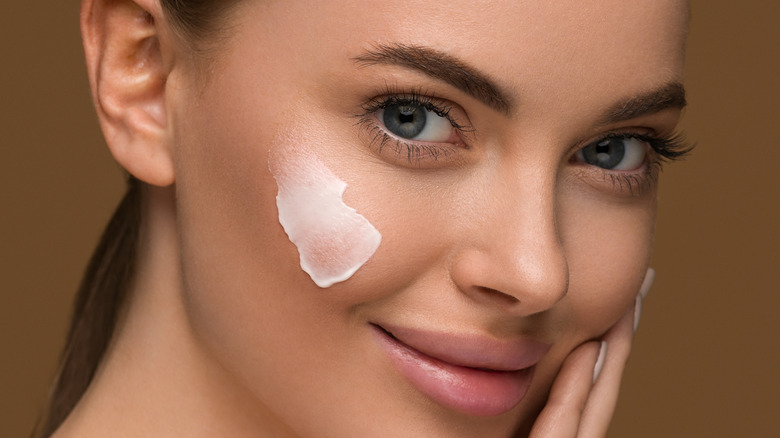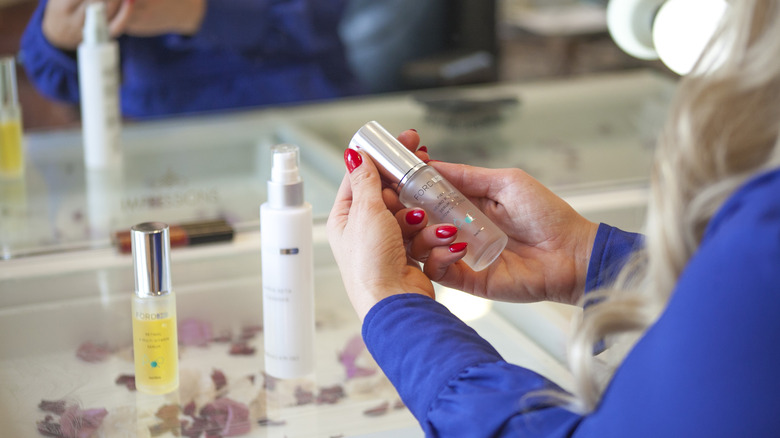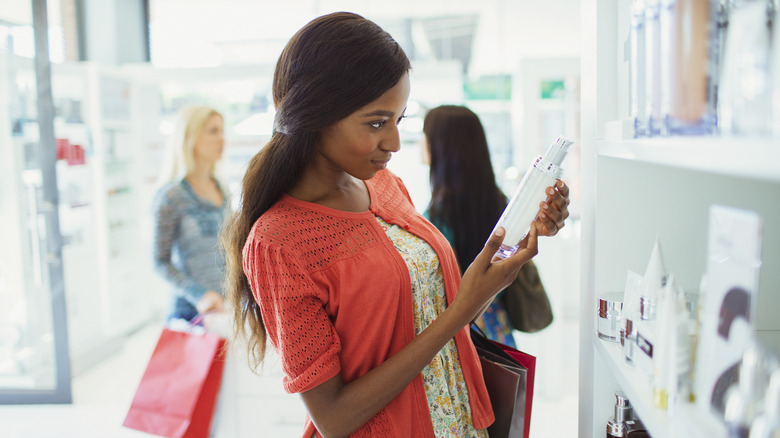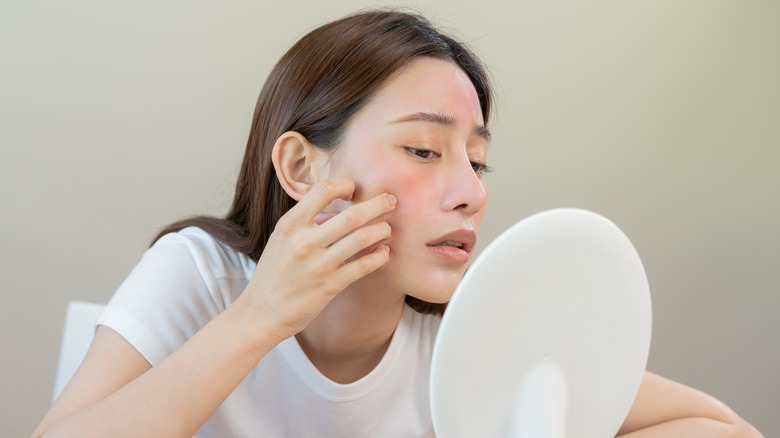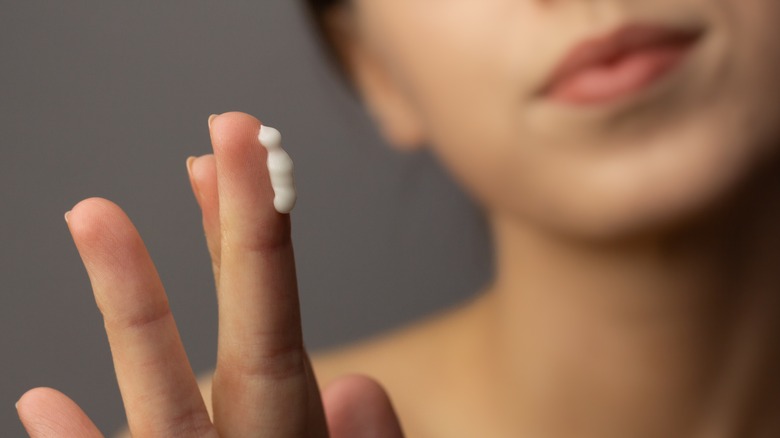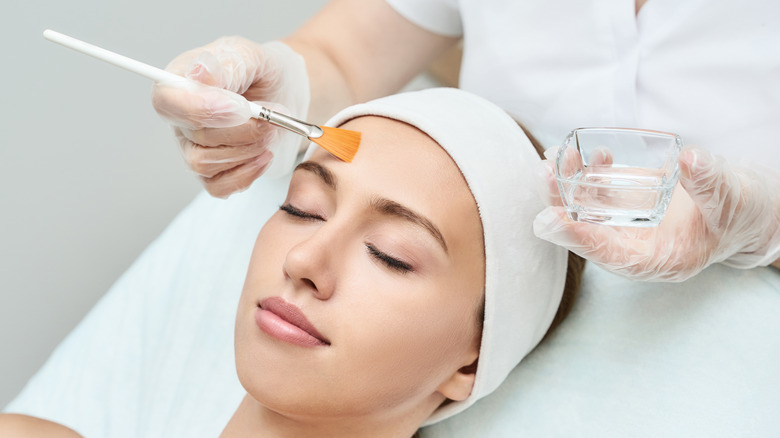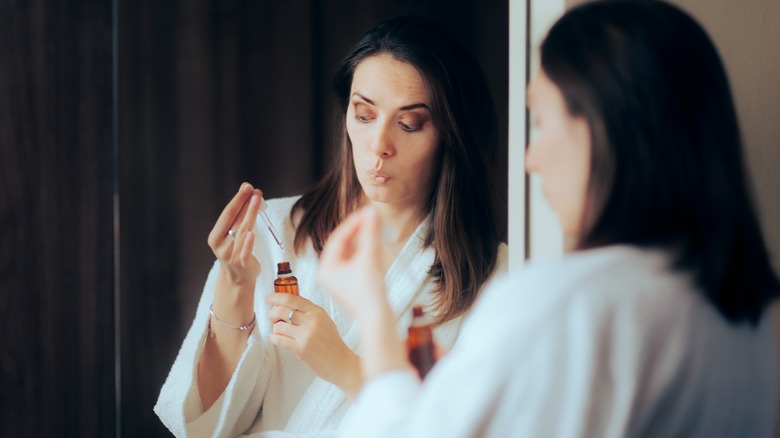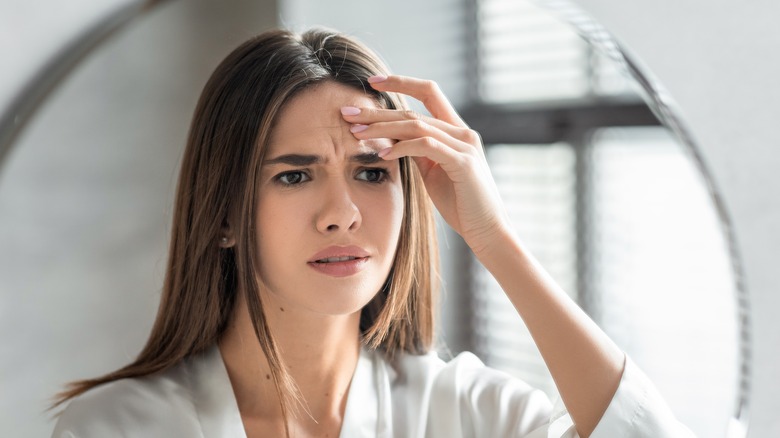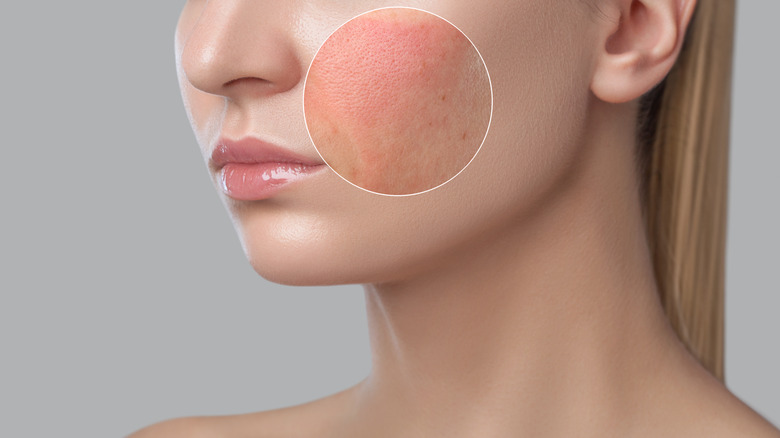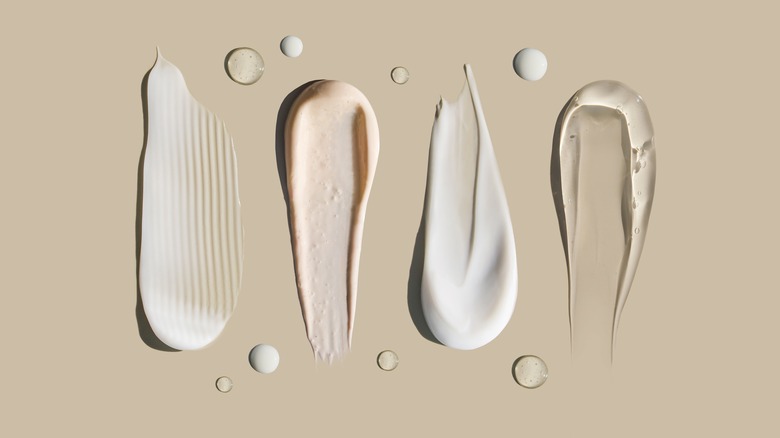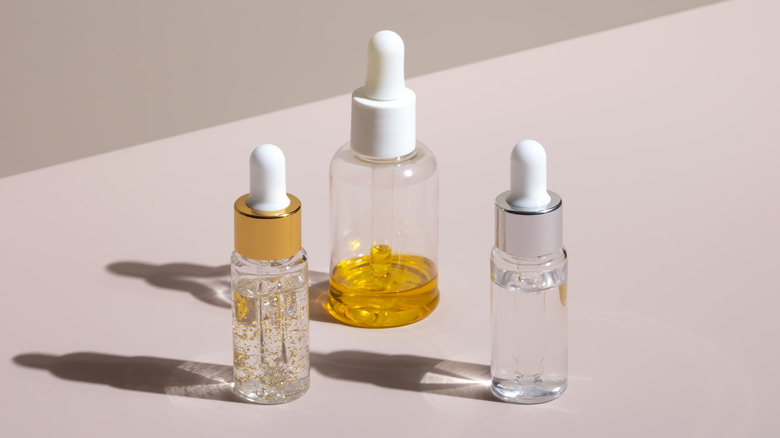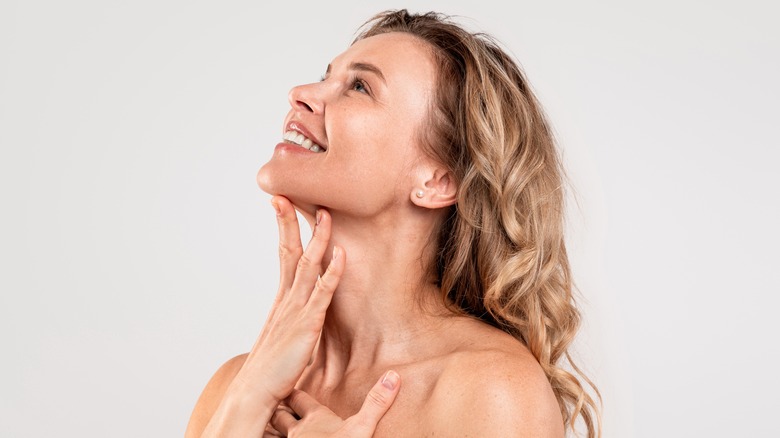What You Need To Know Before Using Retinol
We may receive a commission on purchases made from links.
When getting acquainted with skincare products and ingredients, there are a few that everyone should know. One ingredient that is seemingly gaining popularity is retinol. A potent ingredient, retinol is becoming a must-have ingredient in every skincare routine. According to Future Market Insights, the retinoid industry had a value of $1.5 billion in 2022, growing more and more each year. This increased value is because many big brand names are starting to take an interest in adding retinol to their products. Like with other popular skincare ingredients — we're looking at you, hyaluronic acid and salicylic acid — there's plenty of misinformation on how to add retinol into your routine.
While retinol is a powerful ingredient, you need to have caution while using it. Depending on your skin, you should take extra precautions when using retinol. Even though it can have remarkable results on your skin, it can also cause larger issues if you don't familiarize yourself with its proper usage. Before using retinol, ensure you know all of the information surrounding it to achieve glowy and smooth skin. Luckily for you, we've got you covered.
How to apply retinol
To know how to use retinol, you first need to know what this ingredient is and how it works. As explained by the Cleveland Clinic, retinol is a type of vitamin A used in skincare for anti-aging and acne treatment. Among its uses, retinol can unclog pores, increase cell production, exfoliate the skin, and reduce the look of wrinkles and fine lines through increased collagen production. With all of these benefits, it's no reason why so many want to add retinol to their skincare routine.
To get the most out of your retinol, Dermstore recommends starting with a small concentration of retinol to test how your skin reacts to this ingredient. Start by washing your face and following with eye cream. Because the area around your eyes is delicate, you want to add some protection. Before you apply retinol, ensure your skin is completely dry. Applying retinol to a damp or wet face will dilute it and won't give you all its benefits. Starting from your chin, apply a small amount of retinol product upwards towards your forehead. Once the product has been set, apply moisturizer, and you're finished. Follow up with plenty of sunscreen before stepping outside next, as the combination of sun and retinol can be dangerous for your skin health.
How to start using retinol and when to expect to see results
Even though retinol has a lot to add to your skincare routine, it's not suited for everyone. Skin Pharm explains that people with sensitive skin should start their retinol usage only once a week. If your skin has proven to withstand harsher ingredients, you can use retinol every other day. However, Skin Pharm also suggests starting slow with your retinol regardless of your skin. Starting slow ensures that the retinol doesn't irritate your skin and its potency on your skin lasts longer. In the beginning, your skin is barely getting used to the retinol ingredient, and can take some time before it starts showing its effects.
Prevention explains that it can take as long as four to six months for your skin to start working with the retinol, and you can start seeing the full results. The outlet also adds that you should be aware of anything that could potentially trigger an irritation while you are using retinol. Potential triggers include alcohol-based products, exfoliants, and medicated topical products. Even waxing where you are applying retinol can cause a burning sensation.
Is retinol safe to use with other skincare products?
Before you start adding retinol to your skincare routine, it's vital to know what products are safe to use in conjunction with it. You can end up doing more damage than good to your skin if you combine retinol with the wrong products. The Inkey List explains that since retinol is such a powerful skincare product to depend on, it can't be combined with apple cider vinegar, glycolic acid toners, alpha hydroxy acids (AHAs), lactic acid, or beta hydroxy acids (BHAs).
Still, other ingredients are perfectly fine to use with it. For instance, you can safely use retinol with cleansers, serums, and moisturizers. You have to be wary before incorporating an additional exfoliating product into your routine along with retinol, though. Pairing products that exfoliate your skin on a deeper level can lead to dryness, redness, and irritation. If there is a wonderful exfoliating product that you really want to use, only pull it out on days when you're not using your retinol.
What to look for in a retinol product
There are many things to pay attention to when narrowing down your options for retinol products. Different retinol products come in multiple forms and have varying concentrations that will undoubtedly impact your skin differently. Everyday Health suggests opting for retinol creams or gels that are jam-packed with .025%, .05%, or 0.1% concentrations. Even if you end up choosing a retinol product with a minimal amount of potency, you'll still be able to notice impressive results in the health of your skin.
Modern Dermatology explains that when looking for the best retinol product that will suit you and your needs, you should always start with the lowest concentration before graduating to higher levels. Paying attention to the strength of your retinol product before purchasing will save you in the long run. Ultimately, a retinol product with at least .25% potency will be the most effective thing for you, even if that's not where you can immediately start at the beginning of your skincare journey.
Retinol.com claims that Skin Drop's Advanced Retinol Complex is one of the best possible skincare choices you can select due to its affordability, easiness to use, and a 90-day guarantee. The second best choice would be the Skinceuticals Retinol Cream 1.0 because of its potency, speedy effects, and serious results. Another highly reviewed retinol product is the StriVectin Advanced Retinol Night Moisturizer since a small dab goes a long way, it blends easily, and it gives off a light and fresh scent.
Common side effects of using retinol
Regardless of what items you consider adding to your skincare routine, you should be aware of any possible side effects or allergic reactions that might occur. Skin Type Solutions explains a few of the unfortunate and unwanted side effects that possibly come along with using retinol include stinging, burning, uncomfortable sensations, and a red face. In terms of stinging, retinol can make it so that even a splash of water gives you painful tingles.
When it comes to burning, your skin will feel hot to the touch if retinol simply isn't working out for you. The Skin Spot by Dr. Sheila Nazarian explains that retinol's side effects can include itchiness, dryness, flakiness, peeling, scaling, acne outbreaks, increased sensitivity to sunshine, and even sun cancer in the worst possible cases. Having an allergic reaction to retinol is incredibly rare, but that doesn't mean it's impossible to deal with some of these symptoms based on an allergy response alone.
How long does it take to see results?
If you've decided that you're ready to take the leap and begin using retinol as part of your skincare routine, Healthline advises easing your way in. You can get started by only applying it to your skin a couple of times per week. After several weeks have passed and you are certain that your skin isn't having a negative reaction to the use of it, you can start using it a little more frequently. Although you might be excited about seeing major improvements quickly as possible, it's important to remember that retinol is not an overnight solution.
There's nothing quick about the process of retinol usage since it can take up to six months before you see noteworthy results. Plenty of people will start to see less acne than before after about 12 weeks of regularly using retinol, but bigger issues such as signs of aging and sun damage will generally take a bit longer. When it comes to figuring out the best time to use retinol, Skin Type Solution suggests using it at the end of your day after you've already applied cleanser, eye cream, serums, and moisturizers.
At what age should someone start using retinol in their skincare routine?
One of the questions you might have surrounding retinol usage is whether you should wait until you're older with wrinkles that have already developed or if you should start at a younger age in order to prevent the aging process from starting up in the first place. MarthaStewart.com suggests getting started with retinol in your 20s to increase the regeneration potential of your skin while it is still at an all-time high.
Good RX agrees that starting in your 20s is a great time for those who want to be proactive and preventative about anti-aging. Children and teenagers aren't the typical demographics for a product like retinol since anyone younger than the age of 18 generally isn't dealing with wrinkles or fine lines in any capacity. If you're currently in your 20s, or you're already beyond your 20s, you have the freedom to get started with retinol if your heart desires. However, be cautious about the time of day at which you apply retinol. It should always be applied at night, as it makes your skin more susceptible to the sun's harmful UV rays. Applying it at night will allow the retinol to penetrate deeply into your skin during time when you're not exposed to the sun.
Here's why some people should avoid using retinol
As intriguing as retinol might sound t you, it's not a product that works for everyone. Certain people should avoid using retinol altogether since it's not a one size fits all approach to skincare. Healthline notes that if you're the type of person who loves soaking up sunshine but you're not the best at remembering to apply sunscreen or other sun protection, retinol wouldn't be ideal for you.
Furthermore, KinFertility.com explains that retinol isn't something you should use if you are pregnant or breastfeeding, either. Since an unborn child soaks up a lot of the nutrients of its mother while it's still in the womb, pregnant women need to put a pause on their retinol usage until their baby is born. After their baby is born, new moms can start incorporating retinol back into their routine if they decide not to breastfeed. Retinol can be incredibly risky when it comes to the development of an unborn or newborn child.
Here's what dermatologists say about retinol
The subject of retinol is a hot topic on social media platforms including Instagram, Twitter, and TikTok. What are real dermatologists actually saying about the popular skincare product, though? According to Dr. Lowella Esperanza via The Florida Medical Clinic, retinol impacts of skin on a cellular level to treat conditions including but not limited to acne, wrinkles, fine lines, psoriasis, hyperpigmentation, and keratosis pilaris. From her perspective, it's an ingredient that comes in handy for a multitude of reasons.
What's more, Dr. Mervyn Patterson told Insider, "Retinol undoubtedly makes the skin smoother. You get a positive effect on collagen, that is definitely true. You get an increase of blood flow to the skin – there are lots of positive things that you can say about Retinol." Since people tend to start losing collagen in the face starting in their mid-20s, he suggests incorporating retinol into your routine to create a positive and healthy impact.
What happens to your skin if you suddenly stop using retinol
Imagine this: You've been using retinol regularly for months, but suddenly your supply has run out. If you aren't able to purchase a refill right away, what will possibly happen to your skin? And what happens if you've decided that you simply don't want to continue using retinol moving forward? Skin Type Solutions says that if you're using retinol to treat chronic acne, four to six weeks retinol-free will pass by before you'll see your acne return.
If you've been using retinol to fight back against aging, wrinkles will undoubtedly start to resurface once your retinol usage comes to an end. The good news is that your skin will remain in great condition for several months after you finish using retinol before it starts backtracking. The only way to maintain permanent results from retinol is to continue using it without stopping, which means it's in your best interest to have refills on deck depending on what type of ailment you're treating.
How to know if retinol isn't working for your skin
Even though retinol sounds like one of the most top-notch skincare products to use, it might not pair well with your skin type. If this is the case, it simply means you have the chance to open up your horizons by seeking out new skincare products that actually work for you. Healthline explains that you'll know retinol isn't working for you if more than six months have passed and you haven't seen any results.
If you notice the product piling up on your skin when you apply it, or causing any negative reactions, it's possible that retinol simply isn't absorbing into your skin cells in a way that's healthy. You can tell retinol doesn't work for your skin if the irritation it causes becomes completely unbearable. There is no reason to suffer for beauty results or force yourself to use a skincare product because it works for others. If it doesn't work for you, there is no shame in moving on from it.
How to prevent and treat retinol burn
The unfortunate truth about retinol is that it can definitely damage your skin if you don't take the necessary precautions. One of the most damaging things it can do is cause retinol burn. Ageless Glow says that "retinization" or the "retinol uglies" can happen to you if you're using highly concentrated retinol before your skin is ready to handle it. Healthline adds that if your skin has become inflamed, discolored, or blisteringly red from retinol usage, you should immediately ice the affected area or press a cold compress down to soothe your discomfort.
Stop using retinol and minimize your skincare routine to become as simple and basic as possible throughout your healing process. Think about adding botanicals such as witch hazel or aloe vera to your routine to speed along the healing process. Hypoallergenic moisturizers can also be helpful when dealing with retinol burn because they help rehydrate your skin. You can prevent retinol burn from happening in the first place if you start with a low concentration, buffer your retinol with moisturizer, and make sure that you're also applying sunscreen.
How retinol and retinoids compare
Even though retinol and retinoids sound the same, they are actually slightly different when it comes to skincare. There's nothing inherently interchangeable about retinol and retinoids, which means you have to be extra careful when shopping for products to incorporate into your routine. Retinol and retinoids are both forms of vitamin A and help people achieve anti-aging results. They vary because retinol can easily be purchased over the counter while you need a strict prescription to get your hands on retinoids.
To simplify things, all retinol products are retinoids, but not all retinoids are retinol. Retinoids tend to be stronger than retinol since they have higher concentrations and stronger molecular structures. Retinoids are also FDA-approved, which means clinical trials have been completed to prove their benefits to the world. At the end of the day, most people are fine with using store-bought retinol that doesn't require a doctor's visit.
How retinol and retin-A compare
Acknowledging the difference between retinol and Retin-A is something skincare lovers should do before narrowing down their daily routines. Retin-A is actually the brand name for tretinoin. According to Westlake Dermatology, Retin-A is a medication that's been approved by the FDA to help anyone struggling with acne outbreaks. When you think of Retin-A, you might also think about other brands of tretinoin such as Atralin, Renova, and Avita.
If you're trying to figure out what to use between retinol and Retin-A, it's smart to use retinol first. After that, you can transfer over to Retin-A if that makes the most sense for you and your needs. The main thing that needs to be taken into consideration is the condition of your skin as you get started on your skincare journey. Retin-A is known for penetrating deeply and immediately, while retinol takes its time, so you have to choose the best route for you.
Here's where you can safely apply retinol on your body
In order to be smart about your retinol usage, it's vital to know which body parts you can safely apply it to. Huda Beauty suggests using retinol on your body to promote anti-aging everywhere, along with your face. After all, wrinkles and sun spots can appear just about anywhere. Procoal London explains that it's totally safe to apply retinol to your neck and chest if you do it with caution. Since your neck and chest are exposed to the UV rays of the sun nearly as much as your face, it makes sense that you would want to protect these body parts too.
Making sure that your neck and chest don't "give you away" as you get older is totally possible if you take care of the skin on your face, neck, and chest in the same way. Charlotte Tilbury says that you can also use retinol directly under your eyes, even though the skin feels a little thinner, more delicate, and more fragile there. Using retinol under your eyes will provide you with more radiant results instead of dark and puffy indents. Applying retinol to the back of your hands is also safe to do if you want to keep your hands looking youthful.
